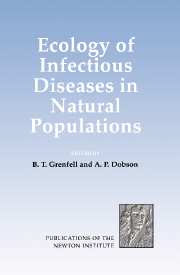Book contents
- Frontmatter
- Contents
- List of Participants
- Introduction
- BROAD PATTERNS AND PROCESSES
- Impact of Infectious Diseases on Wild Animal Populations: a Review
- Microparasites: Observed Patterns
- Mathematical Models for Microparasites of Wildlife
- Microparasite Group Report
- Macroparasites: Observed Patterns
- Mathematical Models for Macroparasites of Wildlife
- Macroparasite Group Report
- Critical Evaluation of Wildlife Disease Models
- PATHOGENS, INSECTS AND PLANTS
- IMPACT OF ECOLOGICAL AND GENETIC HETEROGENEITY
- Glossary
Critical Evaluation of Wildlife Disease Models
Published online by Cambridge University Press: 22 January 2010
- Frontmatter
- Contents
- List of Participants
- Introduction
- BROAD PATTERNS AND PROCESSES
- Impact of Infectious Diseases on Wild Animal Populations: a Review
- Microparasites: Observed Patterns
- Mathematical Models for Microparasites of Wildlife
- Microparasite Group Report
- Macroparasites: Observed Patterns
- Mathematical Models for Macroparasites of Wildlife
- Macroparasite Group Report
- Critical Evaluation of Wildlife Disease Models
- PATHOGENS, INSECTS AND PLANTS
- IMPACT OF ECOLOGICAL AND GENETIC HETEROGENEITY
- Glossary
Summary
Introduction
This paper briefly reviews existing models then attempts to identify some key remaining questions and challenges in the modelling of wildlife diseases. Both the review and the conclusions reflect a pragmatic viewpoint which emphasises the application and biological relevance of models, and focuses on case studies as opposed to general theory (see Heesterbeek and Roberts this volume, Roberts et al. this volume, for a more formal treatment). Moreover the review is by no means exhaustive. Rather I attempted to include sufficient material to cover and allow comment on a range of models and approaches, and to draw some general conclusions on areas of difficulty which deserve future attention.
The Models
Model scope
The basic structural characteristics of the models considered are summarised and compared in Table 1, then points of note, key results and problems with the models are listed in more detail in Table 2. Of the 35 wildlife disease models reviewed, only two were for macroparasites, the gastro-intestinal nematode Trichostrongylus tenuis in red grouse (Model 34, Dobson and Hudson 1992a, b) and the liver parasite Capillaria hepatica as a potential biological control agent of house mice in Australia (Model 35, McCallum and Singleton 1988, Singleton and McCallum 1990). Although an enormous literature exists on models for macroparasitic infections, the great majority relate to domestic animals. In contrast, there appear to be few modelling case studies involving macroparasites in wildlife, possibly because of the complex parasite life cycles and the frequent need for population dynamics data on more than one host.
- Type
- Chapter
- Information
- Ecology of Infectious Diseases in Natural Populations , pp. 230 - 259Publisher: Cambridge University PressPrint publication year: 1995
- 20
- Cited by

